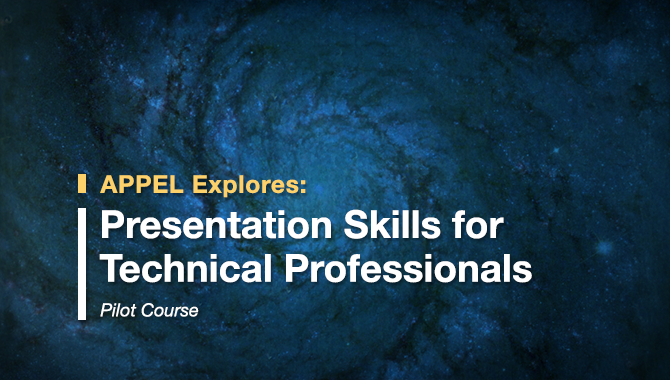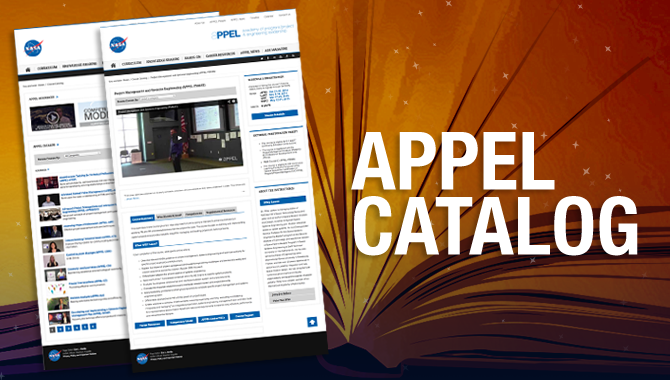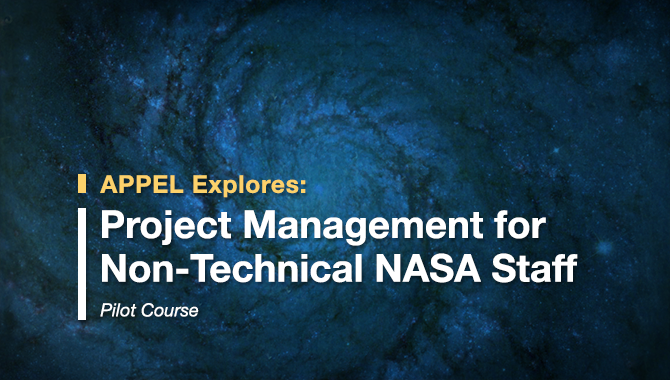
At NASA, presentations are often the means for communicating critical information. A new APPEL course shows people how to maximize the impact of their presentations.
Over the course of a career, each NASA employee typically sits through hours of presentations. The presentation has become the medium for explaining the thinking and decisions behind many of the actions made by programs and projects across the agency. But are the concepts and facts presented to audiences as effectively as possible? APPEL News recently discussed a new APPEL pilot course, Presentation Skills for Technical Professionals, with APPEL Deputy Director Stephen Angelillo, who attended the course, and Matthew Kohut, who taught it. Angelillo and Kohut talked about the unique value of the course and the importance of improving live communication skills at NASA.
APPEL News: Tell us about Presentation Skills for Technical Professionals. What is the course about?
Matthew Kohut: All of the technical professionals at NASA are expected to make presentations at one point or another. And it’s probably safe to say that everybody at the agency has sat through some bad presentations during their career. Presentation Skills for Technical Professionals tries to help change that by giving people a few skills that can make them better presenters. It introduces participants to some best practices so they will get more out of the presentations they give and more out of the presentations they watch. Ultimately, we’re looking for overall improvement in people’s live communication skills.
APPEL News: Why did you think the course would be valuable to NASA employees?
Stephen Angelillo: At NASA, we often present information to groups—small or large—either about our own projects or on information that is valuable to others as they move forward with, or make decisions about, different projects. So being able to connect and communicate effectively with audiences is important for sharing information, getting your message across, and supporting a project (yours or others’) on a successful path forward.
Kohut: If you look at mishap and accident reports at NASA over the past several decades, every single one of them mentions communications as a critical issue. The presentation is really an important medium for explaining a lot of the decisions that people make in their everyday work. So it makes sense that APPEL, as NASA’s internal resource for technical workforce development, would offer something to help people give better presentations.
APPEL News: What are some of the skills that participants will gain from attending Presentation Skills for Technical Professionals?
Angelillo: They’ll learn how to relax in front of a group and present information in an easy-to-understand way. They’ll also learn how to consider their audience’s role in the presentation. For example, how to engage an audience by telling a story or asking questions that relate to the information being presented. And how to gauge their audience’s level of experience and understanding so they provide the right kind of information, the right way, to get that message across. The course also gives insight into what people watching a presentation connect with: how they read body language and how they respond to it. I thought it was interesting that the instructor discussed the way an audience perceives such things as confidence, reassurance, or knowledge of the subject matter based on the presenter’s body language.
Kohut: That’s right. The course focuses both on developing great content and refining your skills as a messenger or a presenter. On the content side, we talk about some best practices for developing and using slides. On the performance side, we go through a whole host of cues that people look for from presenters both in terms of how they use language and how they communicate non-verbally.
APPEL News: Who is the target audience for this course? Is it designed with specific people in mind, or can anyone at NASA benefit from it?
Angelillo: This course offers insight that would be of value to everyone. Whether you’re an experienced presenter or new to presenting, it’ll give you some great insight into reading and engaging the audience, managing your content and your body language, and what kinds of presentations work best.
Kohut: Yes, I’d agree that it’s a course that anyone at NASA could benefit from. If you give presentations and you are interested in continuously improving your communication skills, you’ll probably find something in this course that’ll interest you. It’s clearly very helpful for people who are early and mid career, but it’s gotten very positive responses from people in more senior roles as well.
APPEL News: When you attended Presentation Skills for Technical Professionals, was there anything you found particularly interesting?
Angelillo: Two things were of greatest value to me. First of all, the focus on body language was interesting: the idea that how you stand or move can make your audience more or less at ease and receptive. The second point was about the use of PowerPoint. At NASA, we use a lot of PowerPoint during meetings. I appreciated the instructor’s point that you want to make sure your slides are visually engaging, but you also want to tell a story, because that engages your audience and increases the odds that they retain the information. It also helps the presentation have a greater impact.
APPEL News: Did anything about the course surprise you?
Angelillo: Yes; the willingness of all participants to want to be a better presenter, and the ability to put into action what we had learned. At the end of the class, each of us had to quickly put together a presentation utilizing the tools and insights that were introduced during the course. It was very interesting to see how that information impacted all of our performances as we presented—and how much better we were, how much we’d improved and how much more relaxed we were. It was impressive.
APPEL News: Why did you develop Presentation Skills for Technical Professionals?
Kohut: I’ve been involved with APPEL for about a decade, and I’ve also worked onsite at Goddard Space Flight Center. So I have an inside understanding of NASA and the way that communication happens within the agency. APPEL reached out to me because they knew that I focused on live communications training skills with other government agencies like the Department of Defense and with some big aerospace corporations. So this was an opportunity to bring my NASA background and this emphasis on live communications training together. In the past, APPEL had asked me to provide speaker training for one of their programs for emerging leaders. The invitation to offer this new course was very much a reflection of the enthusiasm that the previous participants felt for the training I’d given them.
APPEL News: The course sounds like it could be very helpful to a range of people at the agency. How can NASA employees get it offered at their centers?
Angelillo: The best way to approach that is for people to contact the APPEL Points of Contact (POCs) at their center. They can find a list of the APPEL POCs for each center on the APPEL website.
__
Presentation Skills for Technical Professionals was piloted at the Academy Center for Excellence in January 2015 and is being evaluated for inclusion in APPEL’s regular course offerings. The instructor, Matthew Kohut, has worked with NASA for over a decade and is the co-author of Compelling People. He is also the managing partner of KNP Communications, a firm that specializes in training focused on presentation skills, executive presence, and media appearances.









